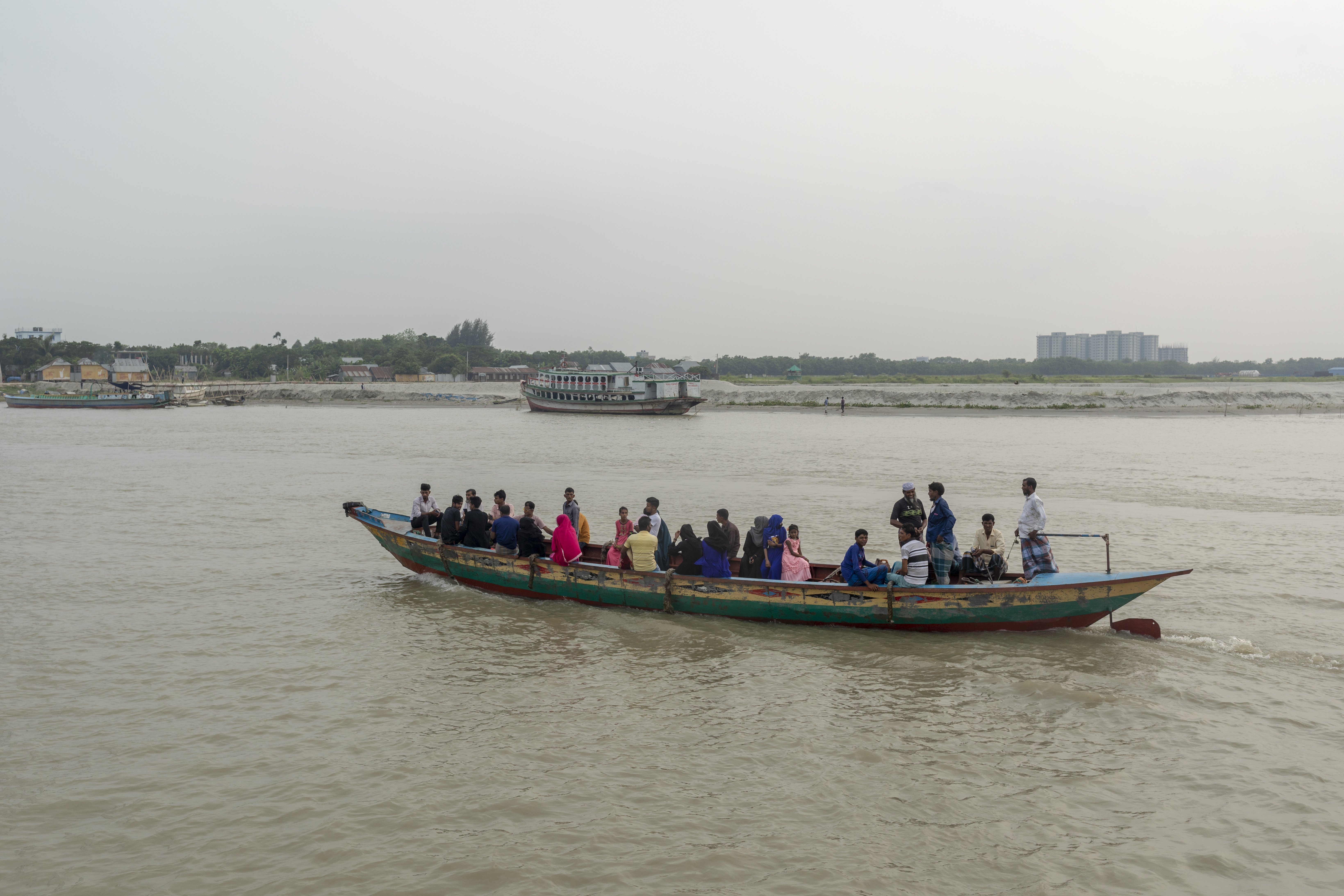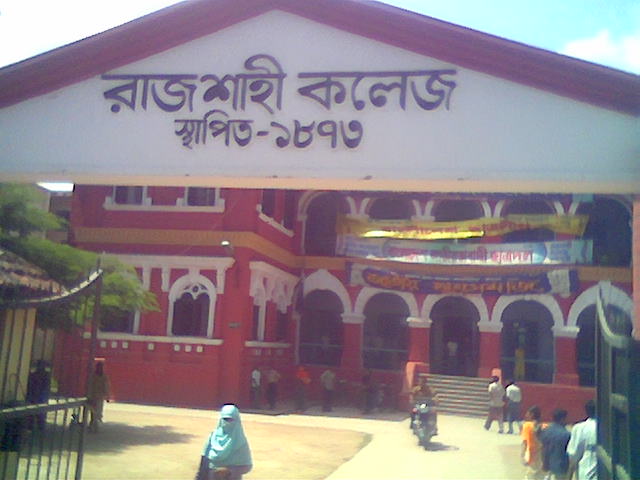|
Boro Kuthi
Boro Kuthi ( bn, বড়কুঠি ) is a historic building in Rajshahi, Bangladesh built by Dutch traders in eighteenth century. The building was also used as the first administrative center for Rajshahi University. The building is now under the Ministry of Cultural affairs to preserve as a cultural heritage, and planned to turn as a museum. History Located on the band of Padma river, it is belied to be built by Dutch traders during first of eighteen century. During that period several other building such at Motihar kuthi were constructed in the area for silk and indigo trading. When Dutch traders left India after the fall of Nawab Siraj ud-Daulah in 1757, they handed over the building to British East India Company. The company later sold the building to Robert Watson and Company in 1833. After the British left in 1947, the building was used as government's supply center. In 1953, the building was handed over to newly started Rajshahi University to use as its administrat ... [...More Info...] [...Related Items...] OR: [Wikipedia] [Google] [Baidu] |
Rajshahi
Rajshahi ( bn, রাজশাহী, ) is a metropolitan city and a major urban, commercial and educational centre of Bangladesh. It is also the administrative seat of the eponymous division and district. Located on the north bank of the Padma River, near the Bangladesh-India border, the city has a population of over 763,580 residents. The town is surrounded by the satellite towns of Nowhata and Katakhali, which together build an urban agglomeration of about 1 million population. Modern Rajshahi lies in the ancient region of Pundravardhana. The foundation of the city dates to 1634, according to epigraphic records at the mausoleum of Sufi saint Shah Makhdum. The area hosted a Dutch settlement in the 18th century. The Rajshahi municipality was constituted during the British Raj in 1876. It was a divisional capital of the Bengal Presidency. Rajshahi is a significant administrative, educational, cultural, and business centre in Bangladesh. It is a historic center of silk pro ... [...More Info...] [...Related Items...] OR: [Wikipedia] [Google] [Baidu] |
Indo-Saracenic Revival Architecture
Indo-Saracenic architecture (also known as Indo-Gothic, Mughal-Gothic, Neo-Mughal, or Hindoo style) was a revivalist architectural style mostly used by British architects in India in the later 19th century, especially in public and government buildings in the British Raj, and the palaces of rulers of the princely states. It drew stylistic and decorative elements from native Indo-Islamic architecture, especially Mughal architecture, which the British regarded as the classic Indian style, and, less often, from Hindu temple architecture. The basic layout and structure of the buildings tended to be close to that used in contemporary buildings in other revivalist styles, such as Gothic revival and Neo-Classical, with specific Indian features and decoration added. The style drew from western exposure to depictions of Indian buildings from about 1795, such as those by William Hodges and the Daniell duo ( William Daniell and his uncle Thomas Daniell). The first Indo-Saracenic buil ... [...More Info...] [...Related Items...] OR: [Wikipedia] [Google] [Baidu] |
Bangladesh
Bangladesh (}, ), officially the People's Republic of Bangladesh, is a country in South Asia. It is the eighth-most populous country in the world, with a population exceeding 165 million people in an area of . Bangladesh is among the most densely populated countries in the world, and shares land borders with India to the west, north, and east, and Myanmar to the southeast; to the south it has a coastline along the Bay of Bengal. It is narrowly separated from Bhutan and Nepal by the Siliguri Corridor; and from China by the Indian state of Sikkim in the north. Dhaka, the capital and largest city, is the nation's political, financial and cultural centre. Chittagong, the second-largest city, is the busiest port on the Bay of Bengal. The official language is Bengali, one of the easternmost branches of the Indo-European language family. Bangladesh forms the sovereign part of the historic and ethnolinguistic region of Bengal, which was divided during the Partition of ... [...More Info...] [...Related Items...] OR: [Wikipedia] [Google] [Baidu] |
Rajshahi University
The University of Rajshahi, also known as Rajshahi University or RU ( bn, রাজশাহী বিশ্ববিদ্যালয়), is a public co-educational research university in Bangladesh situated near the northern Bangladeshi city of Rajshahi in a campus at Motihar, East of the Rajshahi city center. It is the second largest, in terms of academic activities and campus area and also the second oldest, university in Bangladesh. The university's 60 departments are organized into ten faculties. It is considered one of the top research universities in Bangladesh. Researchers of this university have recently contributed a significant amount of effort and played a key role in bringing back medieval Bangladeshi Muslin fiber. It has a formidable alumnus base around Bangladesh and abroad. Because of its beautiful and well-planned verdurous campus, academic atmosphere and traditional inclination towards outdoor sports, it is popularly known as the Cambridge of the East. ... [...More Info...] [...Related Items...] OR: [Wikipedia] [Google] [Baidu] |
Padma
The Padma ( bn, পদ্মা ''Pôdma'') is a major river in Bangladesh. It is the main distributary of the Ganges, flowing generally southeast for to its confluence with the Meghna River near the Bay of Bengal. The city of Rajshahi is situated on the banks of the river.Hossain ML, Mahmud J, Islam J, Khokon ZH and Islam S (eds.) (2005) Padma, Tatthyakosh Vol. 1 and 2, Dhaka, Bangladesh, p. 182 . Since 1966, over of land has been lost due to erosion of the Padma. History Etymology The Padma, Sanskrit for lotus flower, is a mentioned in Hindu mythology as a byname for the Goddess Lakshmi. The name ''Padma'' is given to the lower part of the course of the Ganges (Ganga) below the point of the off-take of the Bhagirathi River (India), another Ganges River distributary also known as the Hooghly River. Padma had, most probably, flowed through a number of channels at different times. Some authors contend that each distributary of the Ganges in its deltaic part is a remnant ... [...More Info...] [...Related Items...] OR: [Wikipedia] [Google] [Baidu] |
Motihar Kuthi
Motihar Kuthi Motihar Kuthi is a colonial building situated at Rajshahi, within the Rajshahi University campus and close to its main gate. It is now used as the office BNCC of the university. In general appearance it is similar to the kuthis of Sardah so it was built in 1781 by Dutch East India Company.* Hussain ABM (2007). Architecture= A History Through Ages. Dhaka:Asiatic Society Of Bangladesh.(page-357) History from 17th to 18th century kuthis were built as a residence or factory engaged in silk and indigo trade. In Rajshahi region alone more than 152 indigo kuthis were in operation with their headquarters at Sardah. Motihar kuthi is one of them. At a short distance there is another kuthi named kaajla. These two kuthis were at one time connected by the tributary river connecting with the Ganges. Exterior and interior Motihar kuthi is one storeyed building facing south, consists of six apartments. three east-west oriented halls behind the southern verandah and three mo ... [...More Info...] [...Related Items...] OR: [Wikipedia] [Google] [Baidu] |
India
India, officially the Republic of India (Hindi: ), is a country in South Asia. It is the seventh-largest country by area, the second-most populous country, and the most populous democracy in the world. Bounded by the Indian Ocean on the south, the Arabian Sea on the southwest, and the Bay of Bengal on the southeast, it shares land borders with Pakistan to the west; China, Nepal, and Bhutan to the north; and Bangladesh and Myanmar to the east. In the Indian Ocean, India is in the vicinity of Sri Lanka and the Maldives; its Andaman and Nicobar Islands share a maritime border with Thailand, Myanmar, and Indonesia. Modern humans arrived on the Indian subcontinent from Africa no later than 55,000 years ago., "Y-Chromosome and Mt-DNA data support the colonization of South Asia by modern humans originating in Africa. ... Coalescence dates for most non-European populations average to between 73–55 ka.", "Modern human beings—''Homo sapiens''—originated in Africa. Then, interm ... [...More Info...] [...Related Items...] OR: [Wikipedia] [Google] [Baidu] |
Siraj Ud-Daulah
Mirza Muhammad Siraj-ud-Daulah ( fa, ; 1733 – 2 July 1757), commonly known as Siraj-ud-Daulah or Siraj ud-Daula, was the last independent Nawab of Bengal. The end of his reign marked the start of the rule of the East India Company over Bengal and later almost all of the Indian subcontinent. Siraj succeeded his maternal grandfather, Alivardi Khan as the Nawab of Bengal in April 1756 at the age of 23. Betrayed by Mir Jafar, the commander of Nawab's army, Siraj lost the Battle of Plassey on 23 June 1757. The forces of the East India Company under Robert Clive invaded and the administration of Bengal fell into the hands of the company. Early life and background Siraj was born to the family of Mirza Muhammad Hashim and Amina Begum in 1733. Soon after his birth, Alivardi Khan, Siraj's maternal grandfather, was appointed the Deputy Governor of Bihar. Amina Begum was the youngest daughter of Alivardi Khan and Princess Sharfunnisa, the paternal aunt of Mir Jafar. His father, M ... [...More Info...] [...Related Items...] OR: [Wikipedia] [Google] [Baidu] |
East India Company
The East India Company (EIC) was an English, and later British, joint-stock company founded in 1600 and dissolved in 1874. It was formed to trade in the Indian Ocean region, initially with the East Indies (the Indian subcontinent and Southeast Asia), and later with East Asia. The company seized control of large parts of the Indian subcontinent, colonised parts of Southeast Asia and Hong Kong. At its peak, the company was the largest corporation in the world. The EIC had its own armed forces in the form of the company's three Presidency armies, totalling about 260,000 soldiers, twice the size of the British army at the time. The operations of the company had a profound effect on the global balance of trade, almost single-handedly reversing the trend of eastward drain of Western bullion, seen since Roman times. Originally chartered as the "Governor and Company of Merchants of London Trading into the East-Indies", the company rose to account for half of the world's trade du ... [...More Info...] [...Related Items...] OR: [Wikipedia] [Google] [Baidu] |
Rajshahi College
Rajshahi College ( bn, রাজশাহী কলেজ ''Rajshahi Kôlej'') is the third oldest institution of higher education in Bangladesh. Established in 1873 in Rajshahi city, it is the third oldest college in Bangladesh after Dhaka College and Chittagong College. In 1895, Rajshahi College was the first institution in the territories now comprising Bangladesh to award a graduate (master's) degree. The first two master's degree candidates, Cayan Uddin Ahmed (Chawyone Uddin Ahmed) and N. N. Lehari, after graduation became Chief Secretary of Bengal and Session Judge respectively. Later both were awarded Khan Bahadur and Roy Bahadur titles. Rajshahi College offers three years bachelor and four years honours degree courses in various disciplines. The college is affiliated with the National University. Since 1996, it has stopped enrolling higher secondary students. It again started enrolling higher secondary students in 2010. Situated in the city center, Rajshahi College is adj ... [...More Info...] [...Related Items...] OR: [Wikipedia] [Google] [Baidu] |




